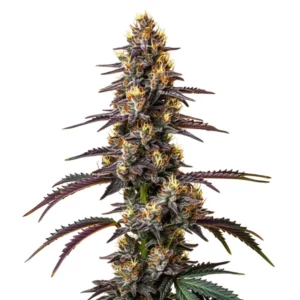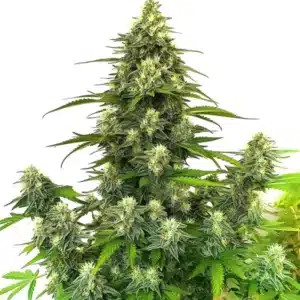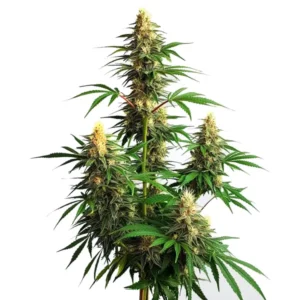As revealed by a recent report by the prestigious British newspaper The Guardian, cannabis cultivation is one of the great hopes for combating climate change on our planet, since plantations act as lungs for the carbon dioxide that we emit into the atmosphere.
This plant has the capacity to absorb up to 30 tons of CO2 per hectare, one of the main greenhouse gasses causing the acceleration of global warming and climate change. In this way, research on the efficient use of hemp has been stripping that image linked to legal prohibitions and recreational uses of the plant, to emerge as a sustainable material for various industries such as textiles, automotive, pharmaceuticals or cosmetics.
Recommended Strains
Jack Herer x Skunk
 THC: 20% - 24%
THC: 20% - 24% Type of seed: Feminized
Type of seed: Feminized Phenotype: Mostly Sativa
Phenotype: Mostly Sativa Day to flower: 8 - 10 weeks
Day to flower: 8 - 10 weeks
Blueberry x Lemon Haze Auto
 THC: 16% - 22%
THC: 16% - 22% Type of seed: Autoflowering
Type of seed: Autoflowering Phenotype: Mostly Sativa
Phenotype: Mostly Sativa Day to flower: 8 - 10 weeks
Day to flower: 8 - 10 weeks
Some benefits of cannabis
Agriculture is among the industries that generate the most CO2, it is estimated that it contributes up to 12.5% of the carbon dioxide emitted by human activities, which translates into 10 billion tons. Hemp can replace several raw materials since with the fibers of this plant biodegradable products can be made from cloth, paper and plastic.
For example, hemp fabrics are soft and resistant, so they would be an ideal substitute for cotton, the crop most used by the textile industry and one of the most polluting.
To produce a kilo of cotton, up to 10,000 liters of water are required, to produce one of hemp fibers only 500, in addition, industrial varieties of cannabis are cultivated almost without using agrochemicals or pesticides, while cotton requires large amounts of these substances, which end up contaminating the soil, in addition, garments made with hemp fabric can last up to 4 times longer.
Hemp also fights deforestation. Currently 42% of the wood felled worldwide is used to manufacture the more than 420 million tons of paper that we consume throughout the planet. Hemp paper is the ideal substitute, while a tree that can be used for pulp can take decades, cannabis is ready in 120 days, in addition, one hectare of this plant will produce four times more material for paper than a similar area full of trees.
Hemp-based plastics also have many benefits, as they can degrade in as little as 80 days, unlike those made from petroleum that take hundreds of years to decompose. Using biodegradable plastics would greatly reduce the more than 8 billion tons of plastics that reach the oceans each year and poison their ecosystems.
New cannabis-based materials are currently being developed to sustainably replace the products that we currently have commercially available, but whose manufacture involves contaminating the environment, an example is hempcrete, a negative carbon material, that is, it absorbs more CO2 than it emits and once installed it continues to sequester CO2 from the atmosphere.
Hemp has it all, CO2 absorption, resistant and sustainable materials, ease and speed of cultivation, it only lacks a law that allows it to unfold its full potential as the wonder crop that it is.
Also we can add that the root system of the plants is strong enough to break the compacted soil, increases the quality of the soil and stabilizes the soil, controlling erosion. So growing cannabis actually regenerates the soil through the phytoremediation process, replenishing it and making it possible to grow produce in areas where the crops were unfit for consumption.
On the other hand, hemp is one of the best phytoremediation plants known to man. Studies have shown the efficacy and ability of industrial hemp to withstand high levels of heavy metals without affecting growth, harvest, or quality. It is well known for reducing nitrogen, cadmium, strontium, and cesium levels in the soil. It has been used in Italy on land poisoned by one of Europe’s largest steel mills and in the Ukraine and near Chernobyl to counteract radioactive soil.
Promos & Deals
More Hemp less Pesticides
You may be surprised to learn that hemp is normally impervious to pests. In contrast to cotton or flax (which are known to use up half the pesticides sprayed on them), growing hemp requires fewer pesticides or herbicides. Pesticides can saturate water sources, such as streams, seas, and lakes. When pesticides contaminate a waterway, they can negatively affect the animals depending on that water source, as well as anyone who ingests them.
Pesticides have been linked to many different ailments, from cancer and birth deformities to ADHD and Alzheimer’s disease, to name a few; in fact, in May 2019, Monsanto was fined a record $2 billion in damages after a California jury found its Roundup herbicide causes cancer. Pesticides are dangerous for the earth, they are also a risk to the well-being of all living things. By growing hemp, we decrease the world’s exposure to poisons and toxins.
More data that supports cannabis as an agent that decontaminates the environment is provided by Ben Dobson, founder and president of Hudson Carbon. This activist points out that if 50 million acres of hemp were produced in the US, a few hundred million tons of carbon could be captured per year on that surface.
Dobson is considered a pioneer in the carbon farming space. His farm in New York’s Hudson Valley is a soil laboratory where researchers found that while trees can capture around six tons of CO2 per year, hemp can absorb up to 16 tons. CO2 is also permanently locked within hemp fibers, which can be used as a raw material to make a wide variety of products, ranging from textiles and construction to car parts and medicines.
However, and as we have already pointed out, this is not the only benefit of hemp plants, since this is one of the fastest growing plants in the world, reaching four meters in height in just 100 days. Also, it can purify the air of greenhouse gases, including absorbing carcinogenic heavy metals such as mercury, lead or cadmium from the soil, elements that, although suitable for food crops, are highly dangerous for the people who consume these plants.
On the other hand, industrial sales are expected to triple in the next 7 years, from $4.71 billion in 2019 to $15.26 billion in 2027. Dobson continues to seek to influence growers and farmers in the USA to join the hemp green hello and also to capture more gasses that pollute the earth every day. The above arises because agriculture is responsible for the use of 60% of the Earth’s surface and how it is treated, according to Dobson.
“We’re really managing and managing more than half of the Earth’s surface,” he said. “We need to regenerate this surface of the Earth into a healthy ecosystem to ensure a future for our children and mitigate the worst effects of climate change.”

Not all is perfect with cannabis and the change climate
But no, everything is perfect with cannabis and climate change because preliminary studies have been carried out, where it has been shown that there is a high polluting impact on marijuana production. This is stated by Jason Quinn, a researcher at Colorado State University.
“We were very surprised by how high the impact is,” says the researcher, director of the university’s Sustainability Research Laboratory. This is why Quinn claims that “There is a real opportunity here to reduce that impact. Consumers may start to ask, ‘Is your cannabis produced indoors or outdoors?'”
Switching to greenhouse or outdoor cultivation could reduce emissions by 42% and 96% respectively, according to the study published in Nature Sustainability. In addition, other data was collected with this investigation, which revealed a large variation in emissions across the country and within some states, with indoor crops in more temperate climates requiring less heating or air conditioning to maintain favorable temperatures and humidity.
For example: Producing 1 ounce (28 g) of dried cannabis on East O’ahu in Hawaii was roughly equivalent to burning 16 gallons (60 liters) of gasoline, creating more than twice the emissions of producing the same amount in southern California, the authors said.
So the researchers suggested that states that have already legalized cultivation should direct indoor production toward regions with more optimal climates, while states that legalize cultivation in the future should consider avoiding indoor production. However, they said that shifting production outdoors could create safety concerns and make it difficult for growers to produce multiple crops a year and ensure consistency.

The best cannabis strain for change climate
Climate change is important to us at Blimburn Seeds for the same reason, here we are going to leave you 3 recommendations of our genetics that you can buy here in the store and that will help prevent global warming. We recommend these 3 weed genetics because, with them, you will harvest plants quickly, without abusing electricity consumption and without emitting large amounts of gasses that can heat up the environment.
Jack Herer x Skunk
Jack Herer x Skunk feminized is one of the varieties that we recommend since it has fast growth and a fast flowering period of 60-70 days. You can get about 24 oz/plant in outdoor cultivation, that is to say a heavy harvest and for indoor cultivation up to 1.82 oz/m2 an unbeatable amount. As if that were not enough, its high potency, which is between 17%-24% THC, is perfect for those users looking for happy effects, which become relaxing and very sociable as the flight progresses.
For medicinal users suffering from fatigue, arthritis or depression, this Jack Herer x Skunk strain is recommended. Alpha Pineno, alpha terpineol, among other terpenes are the ones that give it that aroma between earthy and spicy that this variety has, which combines perfectly with the earthy taste, with notes of incense and aftertaste of wood.

Blueberry x Lemon Haze Auto
Blueberry x Lemon Haze Auto is a photoperiod autoflowering variety that is perfect for outdoor and indoor cultivation in hotter and drier climates as well as in wetter places or with shorter growing seasons. This weed genetics can help with climate change because its complete growing cycle is short, ranging from 8-10 weeks, and it adapts very well to different types of cultivation such as hydroponics or soil crops.
Also, you can get 3.5 oz/plant in outdoor grows and about 0.82 oz/ft2 in indoor grows with Blueberry x Lemon Haze Auto
Effects that will leave you in a cloud with sensations of energy and euphoria that you will feel with each puff of Bluberry x Lemon Haze Auto. This is because this variety concentrates terpenes such as Alpha Caryophillene, Myercene or Linalool among others and also highlights its very marked citrus flavors with berry aftertastes and a hashish background with fruity tones.
2046 Fast Version
The flavors that are a mixture of Haze notes with earthy influences and aftertastes of wood are part of the rich taste delivered by 2046 Fast Version, a super fast flowering variety that only needs 8-10 weeks of flowering, too fast for a variety of photoperiod cannabis. In addition, this variety will take you on a journey that will make you feel happy with a euphoric high and at the end a bearable relaxation that will leave you high and calm.
The potency of 2046 Fast Version is incredible since it is between 20%-26% THC and the plants of this genetics give you great yields since you can get up to 1.96 oz/ft2 indoor and up to 22 oz/plant when grown outdoor. Exterior. Important, it is good to know that you can apply cultivation techniques such as SCROG both indoors and outdoors. Obviously, you can do LST to stretch the lateral arms and some pruning in case you don’t want it to spike too much.
You already have in your hands all the information on how cannabis can help climate change and what are the negative effects that an abuse of energy in large crops can have on the environment. For this reason, we share these three recommendations with you because, if you are a commercial weed breeder, you surely want to be at the top of the latest trends in caring for the environment. See you in the next blog, to continue learning about this plant that we love so much.


















